Cheesemaking: Aged Goat Cheddar
Posted: June 15th, 2010 | Author: Devon | Filed under: England, Recipes | 8 Comments »The first farm we stayed at, Riverside Goats’ Cheese, made two varieties of goat cheese: a fresh cheese with herbs, and an aged cheddar-style cheese.
Yes, that’s mold, but the good kind. This hard cheese is white, with a smooth, mild flavor and a slight earthy tang. This particular specimen is three months old.
I’d never had cheddar cheese from a goat before. I’d always assumed it was a strictly cow thing, and orange like the Tillamook bricks I’ve had all my life. I learned cheddar cheese takes its name from the town of Cheddar, where it has been made for over a thousand years. The “cheddaring” process developed and used there can be applied to kinds of milk beside a cow’s. While we were there, our host prepared a new cheese from scratch.
First, extract a bit of the ol’ goat juice. If I’ve learned one thing about milking a goat it’s that you need to squeeze harder that you may initially be comfortable with. In the words of this farmer, “Don’t worry, you wont hurt them. The kids use their teeth.”
The milk is filtered, then added to a temperature-controlled stainless steel vat. The temperature is raised to around 29 degrees Celsius (84 Fahrenheit). Several grams of a starter culture is added. This is a freeze-dried bacteria of a very particular strain. It looks like flaky, yellow-ish powder. It’s called a “starter” because it starts the cheese.
Stir it in, and let that bacteria multiply in there. The acidity of the milk will begin to raise, which is a good thing. That is a result of the bacteria, and it helps ensure that ONLY good bacteria exists in the milk, and not the kind that can make you violently ill.
Rennet is then added (20 drops or so to the 25 liters of milk we’re using to make this single cheese). Rennet is a combination of enzymes, traditionally extracted from the stomach of mammals (cows, usually), used to digest milk. In cheese making, it coagulates the milk, separating it into the solid stuff used to make cheese (curds) and the liquid (whey).
Within an hour, the milk became custard-like, with a watery liquid covering it. Then comes the fun part: cheddaring.
A “cheddaring knife” (six dull blades held in parallel) is passed through the curds and whey, dicing it up. The size of those diced chunks of curd affects the ultimate texture and taste of the cheese. The goal is to create surfaces inside the curd for the whey to seep away. Too large, it may become lumpy with veins of mold running through. Too small, and the result may dry and become crumbly. She spent a lot of time ensuring the entire vat was cheddared consistently, and no large chunks remained, especially on the bottom.
You then allow the whey to seep from the curd, then drain that whey away.
You leave those curds to drain again, then cut them again. Drain again, then cut again. Then, finally, drain again. The consistency will become drier on each pass, from custard-like, to soft wet tofu, to hard tofu.
The curds at this point is chewy and fairly tasteless. The flavor of cheese tends to come from the bacteria that inhabit it, and develops over time, as that bacteria consumes proteins and sugars in the curds. But before that happens, the curds are milled (broken up by hand) and salted.
The salt helps the flavor. I read recently that salt functions to open up the tastebuds, to allow in flavors that otherwise would be missed by the tongue. The salt also acts a preservative. Also, thanks to the culture, the pH should have dropped to 5.4 or so — acidic enough to keep bad bacteria at bay.
But this bowl of curds is not cheese yet. First it must be drained more, but in a controlled fashion that limits the loss of the protein-rich curds. For that, cheese cloth, a form, and heavy wood blocks are used.
The salted curds are packed into a cylindrical form with holes in it (for drainage) and lined with cheesecloth. Round wood blocks are placed atop it, slowly squeezing the whey out.
Additional blocks are added as the curds are squeezed down. Cheesemakers tend to use the same blocks. The thought is that a bacterial culture unique to their cheesemaking operation lives on the surface of those wood blocks which adds a unique flavor to their cheese.
The contraption in this photo is a spring-loaded squeezer that applies a delicate downward pressure. Too much pressure, and you squeeze out too much moisture. Not enough, and it can rot. The draining can take a full day, or more. Once drained, you extract your squeezed, round-shaped block of curd which is looking more and more like cheese. This particular cheese is only half-drained. It still had more time to go.
Look how small it is compared to the initial vat of milk. Once drained thoroughly, you extract the cheese for the last time from the form and cheesecloth, then set it on a shelf in a cool, ventilated room.
After a few days a fine white mold will cover the cheese. Here is our cheese, about two days old. This mold is a good thing, as it helps hold in moisture, necessary to the bacteria inside. As time passes, other molds may form (as can be seen in the first photo on the three-month cheese). If it gets too nasty, you can wipe the excess mold off with a damp cloth.
For this particular variety of cheddar, there’s not much to do now but wait for the flavor to develop to the desired sharpness. There’s many other things one can do, from poking tiny holes hrough the block so mold can grow inside (as seen in blue cheese), to placing it in a bath of brine. There are hundreds of cheeses out there, and a different method for each.
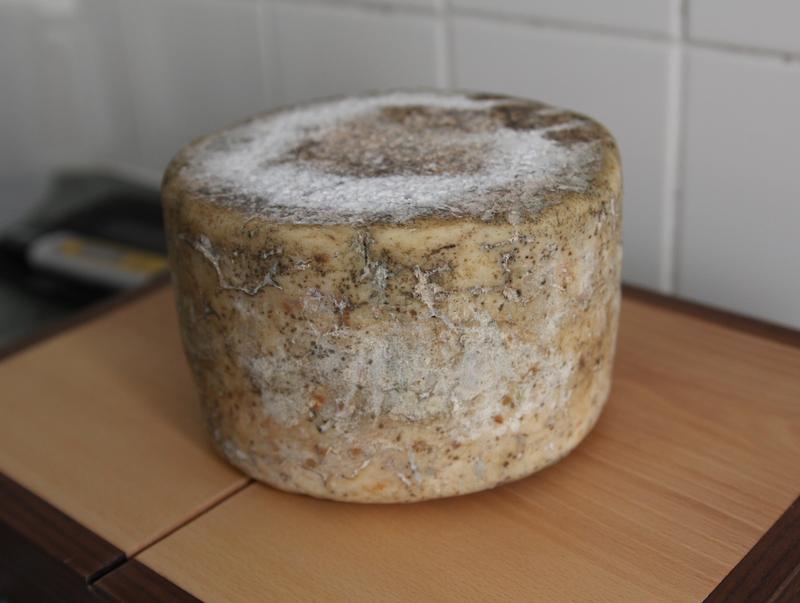
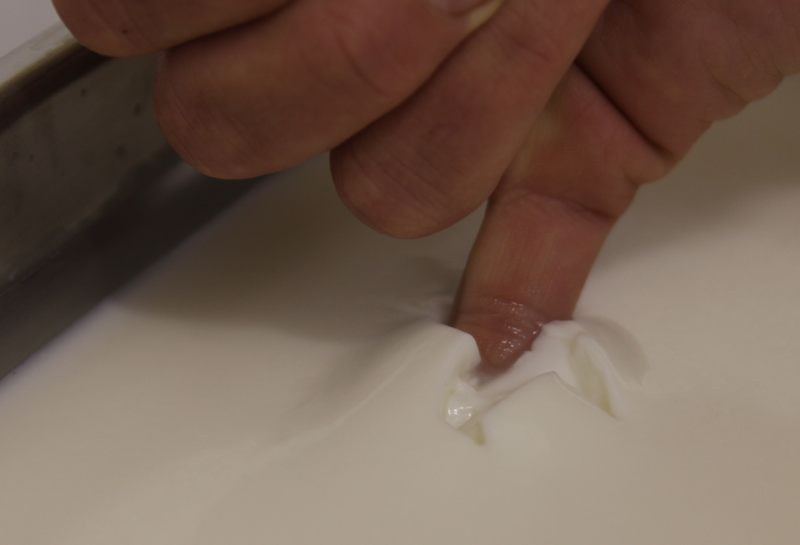
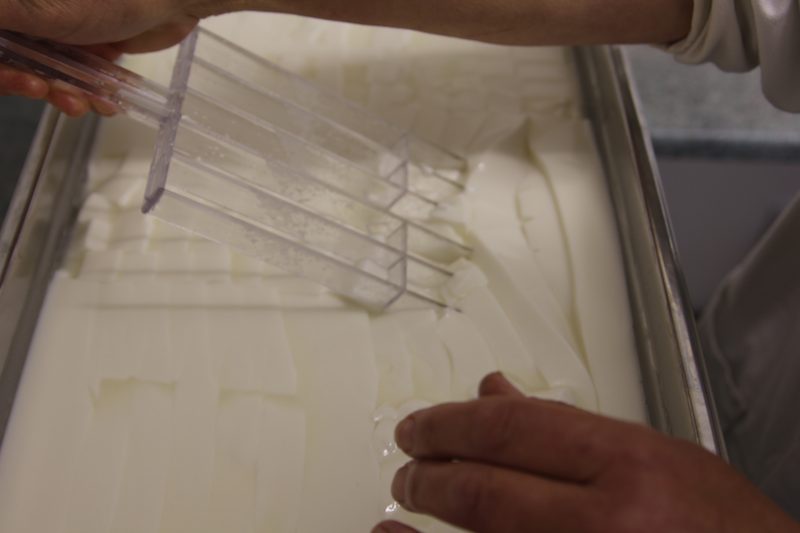
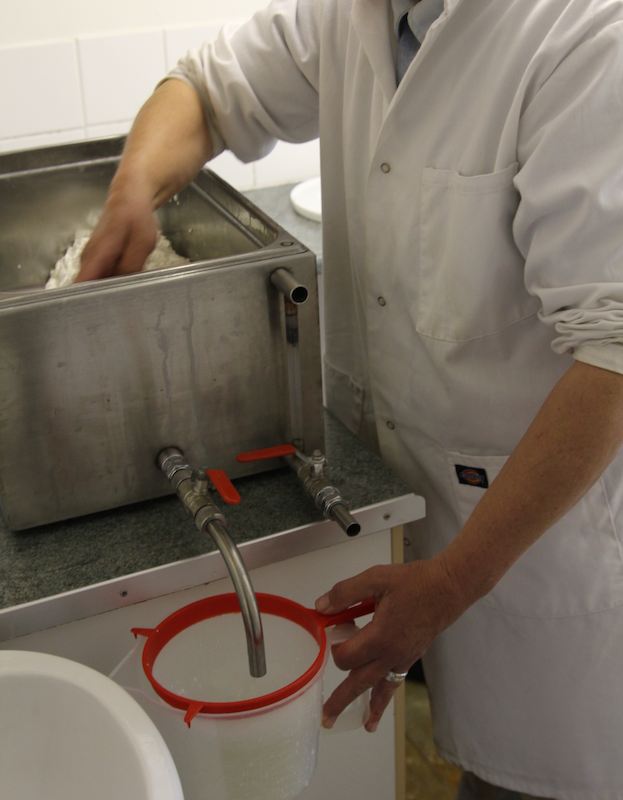
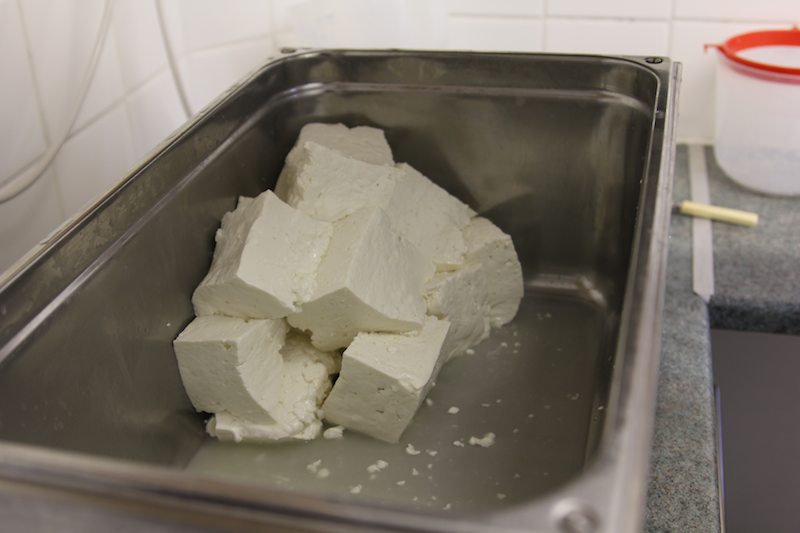
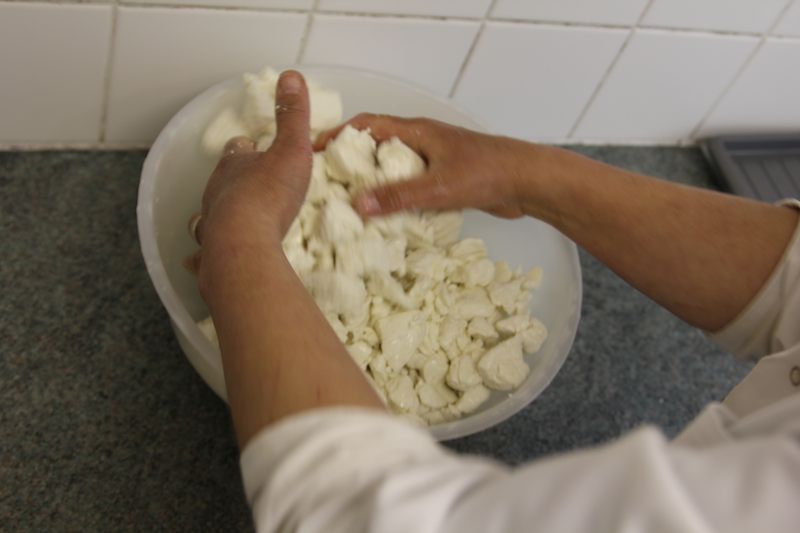
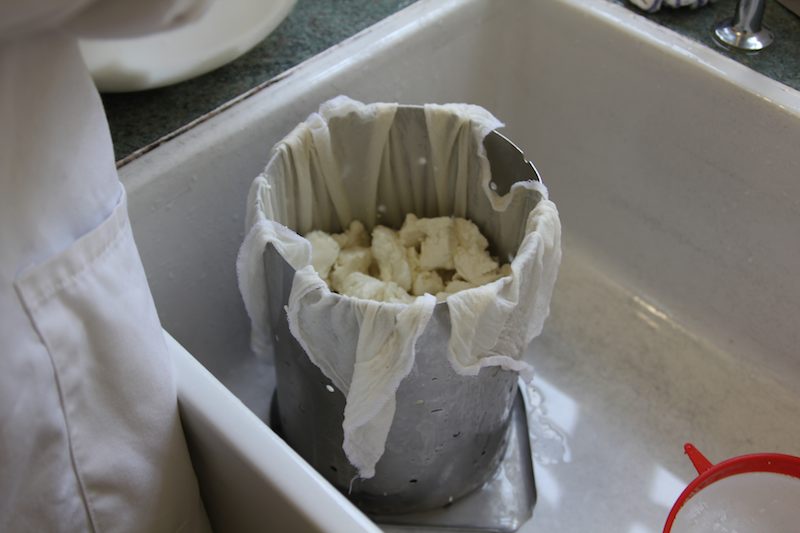

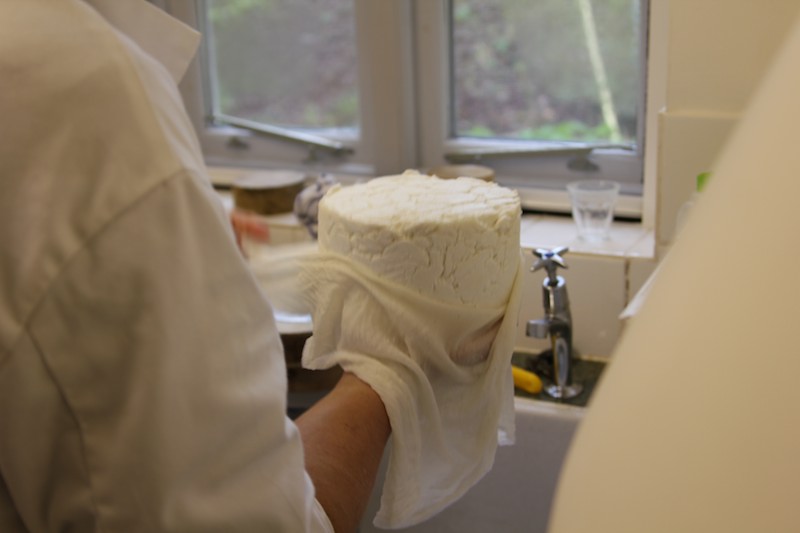
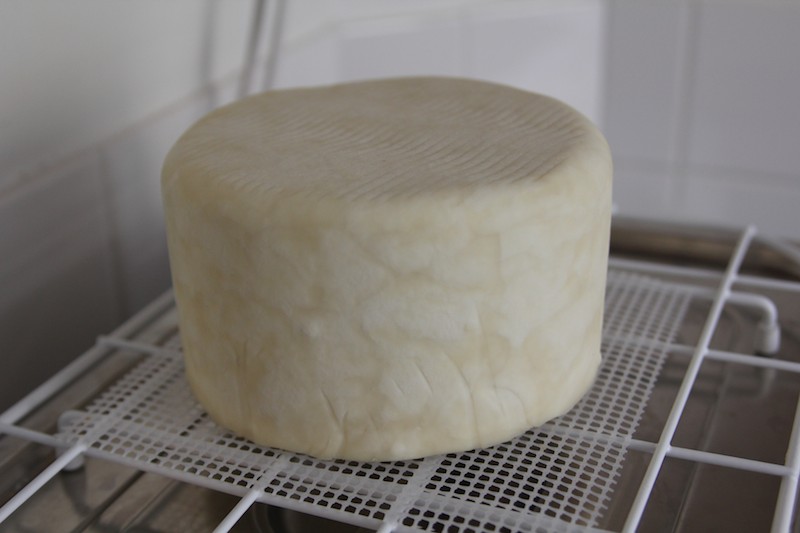
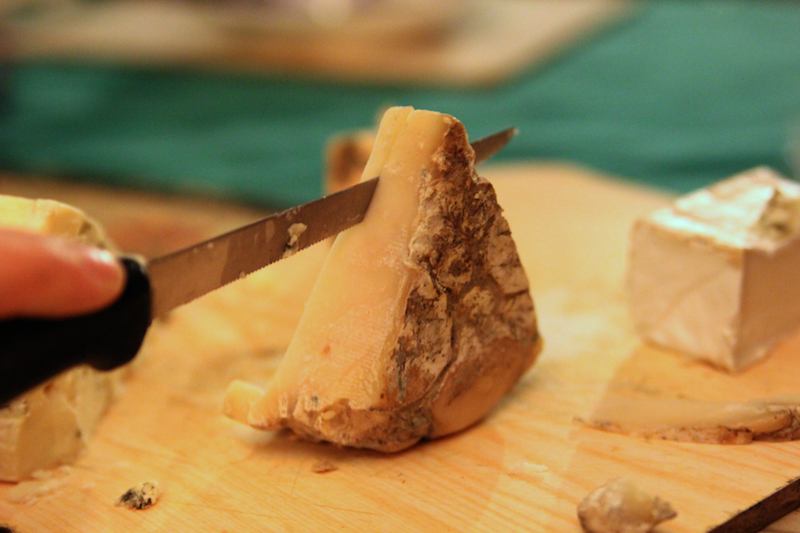
Totally cool – love reading about this!
Wow- great job simplifying & illustrating a complex process! Never knew all those veins in blue cheese were mold … hmmm… mold can be delicious.
Who knew cheesemaking could be so fascinating? (I guess the European Vacation movie was misleading…) Great photos and explanation–you could do documentaries, or at least instructional manuals!
Clearly Miss Muffet was a lazy little girl who couldn’t be bothered to put time and effort into her meal.
Feel so much more knowledgeable about cheese. What happens to the whey?
The pigs eat the whey. They love it!
It looks delicious. Reminds me of the government cheese I grew up on. Expect it’s round and edible.
i like this, it was very informative and i can now accept my cheese